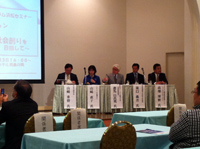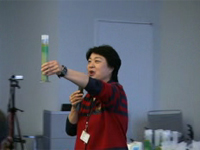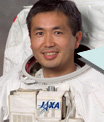JAXA Astronaut Activity Report, February 2011
Last Updated: April 1, 2011
This is JAXA's Japanese astronaut primary activity report for February 2011.
Astronaut Wakata Selected as Member of ISS Expedition Crew

Astronaut Wakata donning a Sokol space suit (Photo Credit: JAXA/NASA)
Astronaut Wakata was officially assigned as a crew member for the International Space Station (ISS) Expedition 38/39 mission.
Wakata is scheduled to stay aboard the ISS for about 6 months from the end of 2013. He will serve as a flight engineer during the Expedition 38 mission, and will serve as the ISS commander during the Expedition 39 mission. Wakata will be the first Japanese astronaut to take command of the ISS.
Astronaut Furukawa Trains for ISS Expedition Mission

Astronaut Furukawa reviewing how to use the ARED (Photo Credit: JAXA/NASA)

Furukawa assisting his crew mate in donning an EMU (Photo Credit: JAXA/NASA)
Astronaut Furukawa continues his pre-flight training program for the Expedition 28/29 mission.
In February, Furukawa visited the Gagarin Cosmonaut Training Center (GCTC) in Russia and JAXA’s Tsukuba Space Center (TKSC) in Japan to take part in training for his upcoming mission aboard the ISS, while continuing the training at NASA’s Johnson Space Center (JSC).
The training at JSC focused on how to operate the Advanced Resistive Exercise Device (ARED), an exercise device that all the ISS crew members aboard the ISS use to keep their muscle strength in space, and how to prepare and assist Extravehicular Activity (EVA) crew in donning an Extravehicular Mobility Unit (EMU).
The training at the GCTC focused mainly on emergency procedures for contingency situations aboard the ISS. Furukawa simulated several different emergency scenarios, such as fire or sudden depressurization caused by a space debris collision, as well as procedures to evacuate into the Soyuz spacecraft. He also learned the Soyuz spacecraft‘s rendezvous/docking and de-orbit/reentry operations procedures.
The training at TKSC included training sessions on Kibo robotic arm (JEM Remote Manipulator System: JEMRMS) operations, the station’s in-flight medical support system, and an experiment to be performed on board Kibo.

Furukawa answering press reporters’ questions after completing an open training (Photo Credit: JAXA)
The training on the in-flight medical support system was opened to the media. The system allows consolidated on-orbit medical management and will provide the crew’s medical data to both the crew on orbit and flight surgeons on the ground. During the training, Furukawa reviewed the medical equipment for the in-flight medical support system, such as the electronic stethoscope, the pulse oximeter, the Holter ECG, the portable ECG, and the USB camera. He also confirmed the connection between the medical equipment and the medical software installed in a laptop computer.
Astronaut Candidate Training
Astronaut candidates Yui, Onishi, and Kanai continue their astronaut candidate training at JSC and other training sites in the United States.
They participated in language lessons and flight training using a T-38 jet trainer. Yui participated in operation training on the Space Station Remote Manipulator System (SSRMS) to enhance his skills and deepen his knowledge on the robotic arm operations. Onishi participated in EVA training at JSC’s Neutral Buoyancy Laboratory (NBL). Kanai visited the Mission Control Center (MCC) at JSC to learn about the console job of the CAPCOM (Capsule Communicator), who is responsible for voice communications with the crew members aboard the ISS.
Astronaut Yamazaki Participates in Kibo Utilization Forum

Astronaut Yamazaki (second from left) attending a panel discussion (Photo Credit: JAXA)
On February 3, Astronaut Yamazaki participated in JAXA’s Kibo Utilization Forum- Hamamatsu Seminar subtitled “To Make a Safer Community” held at the Grand Hotel Hamamatsu in Hamamatsu City, Shizuoka Prefecture.
The seminar included a panel discussion and several lectures that focused on Kibo utilization and global disaster management utilizing space-based applications.
While showing pictures she took during the STS-131 mission in April 2010, Yamazaki introduced a new prospect of Kibo utilization, saying that Kibo can be utilized as a disaster observatory that monitors natural disasters or other catastrophic events on Earth. Hiroki Takabatake, the mission manager of JAXA’s Satellite Utilization Promotion Center, who was also one of the panelists in the discussion, discussed with the other panelists how to establish an organic system for disaster management that links the ground with Kibo and JAXA’s communication and Earth observation satellites.
“Mission X” Educational Activity to Learn Nutrition and Physical Exercise from Astronaut Health Management

Astronaut Mukai teaching a class (Photo Credit: JAXA)
Astronaut Mukai, Chief of the JAXA Space Biomedical Research Office (J-SBRO), held a Mission X education class at TKSC. During the event, Mukai taught students attending the class about the Japanese astronauts’ health management system, which JAXA has established through their experiences in space medicine and life science activities.
The Mission X project is a nutrition and fitness initiative for 8- to 12-year-old children. Multinational organizations participate in this challenge-based health promotion project.
During the event, children tried to catch a falling object (ruler), measured the oil content of potato chips, and learned about food with high oil content.







